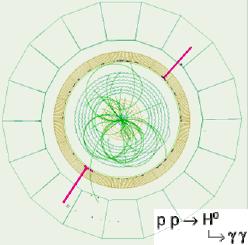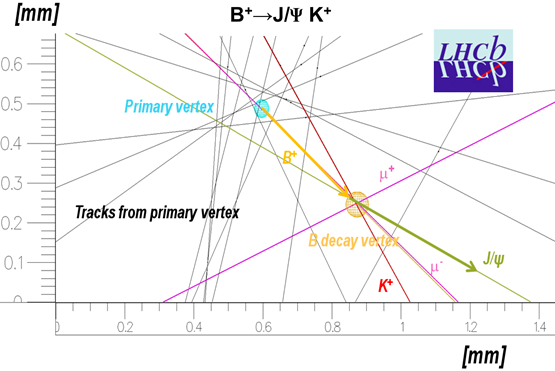Taking a closer look at LHC
It´s measured in “barn” – 1 b = 10-24 cm2
The number of events per second ( Nev) for a specific result is got from:
Nevents/sec = Luminosity · Cross Section
Nevent/sec = L·σevent
It´s therefore easy to understand that luminosity is very important in order to consider the possibilities that an expected event can occur.
The total proton-proton cross section at 7 TeV is approximately 110 mbarns. This total can be broken down in contributions from:
• inelastic = 60 mbarn
• single diffractive = 10 mbarn
• elastic = 40 mbarn
The cross section from elastic scattering of the protons and diffractive events will not be seen by the detectors as it is only the inelastic scatterings that give rise to particles at sufficient high angles with respect to the beam axis.
Inelastic event rate at nominal luminosity is (we take L ~ 1034):
Nevent/sec = L·σ event
1034 x [(60x10-3)x10-24]= 600 million/second
With about 30 millions crosses/s:
600/30 ⇒ 20 inelastic events per crossing.
|
Let´s see an other example:
The cross section to get a 125 GeV Higgs Boson is ~103 fb (femto-barn) via qq ⇒ Zh (see graph below). So, σ = (103·10-15)·10-24cm2 ⇒ σ = 10-36 cm2 Nevent/sec =(1034)·(10-36) Nevents/sec = 10-2 |
 |
Therefore there are 10-2 events per second in which this Higgs boson will be appearing.
To understand this better we can calculate the inverse of that quantity,
t = 1/(10-2) = 100 s
So, every 100 seconds one Higgs particule should be appearing. Therefore, in 10 hours-day work, ~ 360 Higgs particules should be detected.
But hundred of billions of collisions will be produced in the detector in that time. The work of the computers is collosal.
The next figure shows de cross section Higgs production at LHC.

(Taken from Flip Tanedo, An Idiosyncratic Introduction to the Higgs)
Let’s study a third exemple.
LHCb is the experiment dedicated to quark b physics at the LHC. Its primary goal is to look for indirect evidence of new physics in CP violation and rare decays of hadrons which contains b and c quarks.
Compared to other existing accelerators that are in operation the LHC is by far the most copious source of B mesons, due to the high bƃ cross section (σ ~ 500 μb at 14 TeV) and high luminosity (2·1032 cm-2 s-1, on average).

So, let’s calculate the number of events (bƃ pairs):
Nevent/sec = σ x L ⇒ Nevent/sec = (500·10-6·10-24)x(2·1032)
Nevent/sec = 105 bƃ pairs/second
The canonical one year data taking correponds to ~280 hours (~107 s)
So,
(105 bƃ pairs/s)x(107 s/yr) =1012 bƃ pairs/year
|
AUTHORS Xabier Cid Vidal, PhD in experimental Particle Physics for Santiago University (USC). Research Fellow in experimental Particle Physics at CERN from January 2013 to Decembre 2015. He was until 2022 linked to the Department of Particle Physics of the USC as a "Juan de La Cierva", "Ramon y Cajal" fellow (Spanish Postdoctoral Senior Grants), and Associate Professor. Since 2023 is Senior Lecturer in that Department.(ORCID). Ramon Cid Manzano, until his retirement in 2020 was secondary school Physics Teacher at IES de SAR (Santiago - Spain), and part-time Lecturer (Profesor Asociado) in Faculty of Education at the University of Santiago (Spain). He has a Degree in Physics and a Degree in Chemistry, and he is PhD for Santiago University (USC) (ORCID). |
CERN CERN Experimental Physics Department CERN and the Environment |
LHC |
IMPORTANT NOTICE
For the bibliography used when writing this Section please go to the References Section
© Xabier Cid Vidal & Ramon Cid - rcid@lhc-closer.es | SANTIAGO (SPAIN) |



